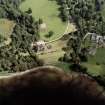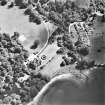Ardkinglas House, The Old House
Country House (19th Century) (1835)-(1908)
Site Name Ardkinglas House, The Old House
Classification Country House (19th Century) (1835)-(1908)
Alternative Name(s) Old Ardkinglas House (C.1835-1908); Ardkinglas House Policies
Canmore ID 146618
Site Number NN11SE 27
NGR NN 17542 10154
Datum OSGB36 - NGR
Permalink http://canmore.org.uk/site/146618
- Council Argyll And Bute
- Parish Lochgoilhead And Kilmorich
- Former Region Strathclyde
- Former District Argyll And Bute
- Former County Argyll
Field Visit (May 1989)
The existing baronial mansion [NN11SE 21] standing in terraced gardens 75m from the SE shore of Loch Fyne is one of the outstanding works of Sir Robert Lorimer, having been built for Sir Andrew Noble between 1906 and 1908 (en.1). It thus falls outside the scope of this Inventory, but it stands in policies which were originally laid out round the castle (NN11SE 2) that continued to be occupied until the 1790s. Lorimer was the last of a series of distinguished architects who provided designs for the replacement of this castle and its successor, a large plain building of about 1795 which was destroyed by fire in 1831 (NN11SE 8).
The immediate precursor of the present house was a modest building of one-and-a-half storeys situated 200m to the S (NN11SE 27), which is said to have been converted from a stable or coach-house some time after the 1831 fire (en.2). Its NE front had a low central gable and seven bays of dormer-windows, which were continued along the side-walls, but only a much-altered fragment of the NW end of the building survives. The square court of offices 90m W of this building was rebuilt by Lorimer on the same site.
Roy's Map of about 1750 shows that the old castle was associated with a series of enclosures between the Allt an Fichead Sgillinne and the Kinglas Water, and a large block of woodland extending inland from Loch Fyne W of the former stream. This western plantation was considerably reduced in extent by the time of James Playfair's survey of 1791, but the mature silver firs admired by Cockburn in 1848 were probably planted soon after 1750 in the valley of the Kinglas Water, where there is a notable arboretum. Playfair proposed a walled garden in the field SE of the present house, but a garden of the same D-plan was built 150m ENE of the house site, probably in the early 19th century. It is enclosed by a rubble wall 3.1m high with sandstone coping and an arched NE gateway. Cockburn in 1848 referred to the grounds as being recently 'reformed', with an excellent flower-garden, and described the artificial lake or 'Caspian Sea', some 180m in length, which is situated 50m N of the house. An ornamental garden SW of the walled one, and those round the mansion, were formed during the present century (en.3*).
RCAHMS 1992, visited May 1989
[see RCAHMS 1992 No. 149 for demolished and unexecuted buildings]
Project (2009 - 2011)
Cairndow is a Highland village at the head of Loch Fyne in Argyll. The are of the parish is some 15,000 hectares . The resident population is about 200 but over 200 people work here.
Here We Are is a community initiative to develop and sustain Cairndow as a cohesive community for the benefit of residents, workers and visitors.
Cairndow village - the parish of Kilmorich - in Argyll, stretches from The Rest and Be Thankful pass down to, and then around the head of Loch Fyne on the road to Inveraray.
From 1900 until the 1960’s most of the land and the dwelling houses belonged to one landowner – Ardkinglas estate. By 2000 there were several landowners and most of the houses are now privately owned. Some families have been here for generations, others arrived only recently: thus it is a good example of a Highland village, representing continuity and change.
OUR HOUSES: THEIR STORIES is a biography of the 107 houses and of those who lived – and live – in them, their livelihoods and their occupations.
The first thing we did was photograph the houses. Then people began to give us and to send photos. The collection grew and we realised we have a gallery of people who had lived in the houses. From this the idea of “Our Houses: Their Stories” emerged.
Alice Beattie, Cairndow born and bred, listed who lived in which house from the 1841 census onwards. Every house and everybody who lived here was given a unique number.
With advice from Scottish Studies at Edinburgh University we recorded Nigel Callander and John MacDonald. Together, the two have rebuilt and renovated our buildings for over half a century.
Architects and Archaeologists from Simpson & Brown of Edinburgh have assessed building phases and architectural detailing of 60 of our houses.
Information from:
http://www.ourhousestheirstories.com/


























